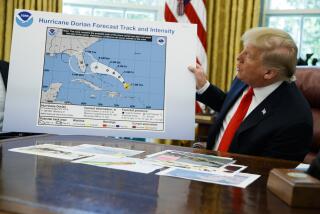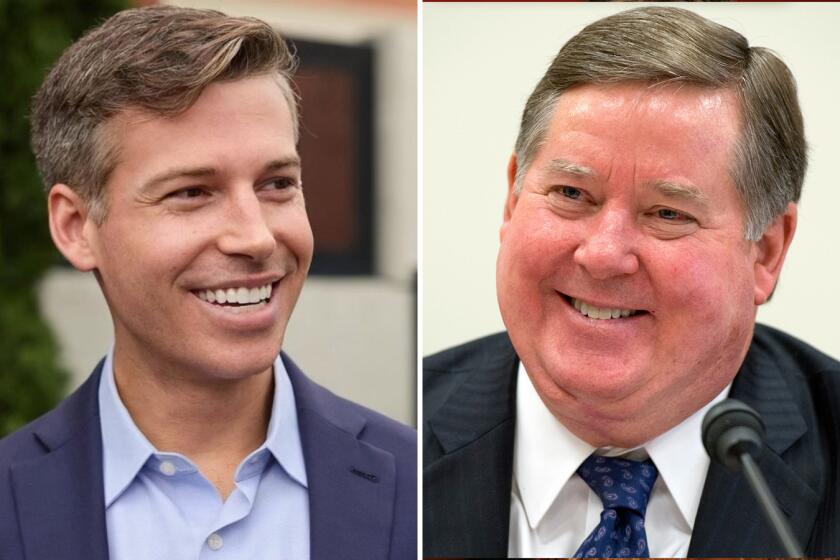Few of Trump’s environmental claims stand up to scrutiny
Reporting from Washington — President Trump on Monday held himself out as a leader in the fight to protect America’s air and water, despite two years of policies that have weakened environmental regulations.
In a speech at the White House, Trump said his administration was working “harder than many previous administrations, maybe almost all of them” to protect the environment. During his campaign, and since taking office, however, Trump has allied himself with coal, oil and gas industry groups, nominated a former energy lobbyist to run the Environmental Protection Agency and vowed to pull out of the Paris climate accord. He’s also pushed for the repeal of regulations that would have cracked down on coal-burning power plants.
This last move led the American Lung Assn. to announce on Monday that it plans to sue the administration for violating the Clean Air Act — highlighting the contrast between the president’s desire to be seen as an environmental leader and widespread criticism of his policies by public health advocates and environmentalists.
What Trump said: “From day one, my administration has made it a top priority to ensure that America has among the very cleanest air and cleanest water on the planet.”
The record: Air quality has improved in the United States since the 1970s. The passage of the Clean Air Act forced emissions reductions across the country, and that led to less smog. But it would be incorrect to say, as Trump has before, that the U.S. has the cleanest air.
According to the latest Environmental Performance Index, compiled every two years by Yale and Columbia University researchers, America ranks 10th for air quality. Australia, Canada, Denmark and Finland have cleaner air.
There are signs that U.S. air quality is deteriorating. EPA data show that there were more days of polluted air during each of Trump’s first two years in office than during any of the four years before. When scientists at New York University and the American Thoracic Society studied air pollution between 2008 and 2017, they found that in many U.S. cities, more people are being exposed to unhealthy levels of ozone, the key pollutant in smog that is linked to asthma and other respiratory illnesses.
The problem is especially severe in Southern California, where the Trump administration’s plans to freeze tailpipe emissions at 2020 levels threaten the state’s air pollution and greenhouse gas-reduction goals.
“If you’re looking at how the U.S. is doing as compared to 1970, there is a tremendous amount of progress, and no one would deny that,” said Stan Meiburg, a former EPA deputy administrator who left the agency in 2017. “The irony is that progress was made because of actions taken by previous administrations, which he has strenuously objected to.”
What Trump said: “Today the United States is ranked — listen to this — No. 1 in the world for access to clean drinking water.”
The record: The U.S. has safe drinking water, earning the highest ranking, according to the Environmental Performance Index. However, that distinction is shared by nine other countries, including Canada, England and Spain.
The fact remains that many Americans in rural and impoverished parts of the country lack safe drinking water. In California, for example, some estimates suggest that more than a million people don’t have access to clean water.
Under Trump, the EPA has been criticized for not doing enough to make drinking water safer in the U.S.
One often-cited example is the agency’s approach to setting safety limits for a class of toxic chemicals that have been found in public water systems and private wells. Used for decades in furniture, clothing, Teflon-coated cookware and firefighting foam, perfluoroalkyl and polyfluoroalkyl substances, known as PFAS, have been linked to cancer and other health problems. Though some states have increased regulation of the chemicals, environmentalists and some members of Congress have accused the EPA of stalling. Agency officials have said they will begin work on an “action plan” by the end of this year.
The administration is also planning to roll back Clean Water Act protections on millions of acres of waterways and wetlands, including up to two-thirds of California’s inland streams. The EPA’s plans call for stripping federal protections from many of the nation’s wetlands and streams.
What Trump said: “Since 2000, our nation’s energy-related carbon emissions have declined more than any other country on Earth. Emissions are projected to drop in 2019 and 2020.”
The record: This is misleading. U.S. emissions of carbon dioxide were decreasing before Trump took office. In the aftermath of the 2008 recession, a shrinking economy meant less demand for energy, which translated to lower greenhouse gas emissions.
But after three years of decline, emissions increased in 2018, according to a report by the Rhodium Group, an independent research firm that tracks CO2 emissions. That occurred even as more coal-burning power plants in the U.S. were retired and replaced primarily with natural gas and renewable energy from solar and wind.
Trump is correct that the latest projections from the U.S. Energy Information Administration that show that emissions could fall in the next two years. But this is because of forecasts predicting milder winters and summers, resulting in lower energy usage.
What Trump said: “Thousands and thousands of tons of this debris float onto our shores after it’s dumped into the oceans by other countries.”
The record: When talking about pollution from plastics in the ocean, Trump often places the blame on Asian countries. In fact, the U.S. is a leading exporter of plastic waste.
The Trump administration repeatedly has said that ridding the world’s oceans of plastic debris is a priority, but it’s difficult to find evidence of that. Last spring, when more than 180 countries agreed to tighten regulations on the global trade in plastic waste, the U.S. opposed the deal. In their statement to the U.N. Environment Assembly, U.S. officials acknowledged that dumping millions of tons of plastic debris into the ocean “required urgent action.” Yet they opposed what they called a “prescriptive approach,” drawing criticism from environmentalists who accused the administration of being beholden to plastics producers.
More to Read
Get the L.A. Times Politics newsletter
Deeply reported insights into legislation, politics and policy from Sacramento, Washington and beyond. In your inbox three times per week.
You may occasionally receive promotional content from the Los Angeles Times.











